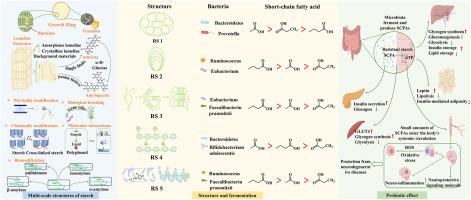Key structural domains of resistant starch and their role in modulating gut microbiota and short-chain fatty acids production
IF 11
1区 农林科学
Q1 CHEMISTRY, APPLIED
引用次数: 0
Abstract
Resistant starch (RS), an indigestible dietary carbohydrate, plays a pivotal role in modulating gut health through microbial fermentation to short-chain fatty acids (SCFAs) including acetate, propionate, and butyrate which mediate multiple health benefits. Accumulating evidence highlights that the digestive resistance and fermentative behavior of RS are fundamentally determined by its structural characteristics, such as amylose-to-amylopectin ratio, granule morphology, crystalline type, chain-length distribution, and interactions with other food components. This review provides a comprehensive synthesis of current knowledge on the classification and structural domains of RS, their influence on fermentation kinetics and SCFA profiles, and their interactions with gut microbiota. Additionally, we discuss how these structure-function relationships translate into health outcomes and inform the development of functional starch ingredients. Emerging strategies, including genetic breeding for high amylose content, controlled physical processing, chemical modification, and esterification with SCFAs, offer opportunities to tailor RS properties for specific nutritional goals. Future research directions should further clarify how these structural attributes can be leveraged within precision nutrition frameworks to develop functional foods and dietary interventions aligned with individual microbiome variability and health needs.

抗性淀粉的关键结构域及其在调节肠道菌群和短链脂肪酸生产中的作用
抗性淀粉(RS)是一种不易消化的膳食碳水化合物,在调节肠道健康中起着关键作用,通过微生物发酵产生短链脂肪酸(SCFAs),包括乙酸、丙酸和丁酸,介导多种健康益处。越来越多的证据表明,RS的消化抗性和发酵行为从根本上取决于其结构特征,如直链淀粉与支链淀粉的比例、颗粒形态、晶体类型、链长分布以及与其他食物成分的相互作用。本文综述了RS的分类和结构域,它们对发酵动力学和SCFA谱的影响,以及它们与肠道微生物群的相互作用。此外,我们还讨论了这些结构-功能关系如何转化为健康结果,并为功能性淀粉成分的开发提供信息。新兴的策略,包括高直链淀粉含量的遗传育种、受控的物理处理、化学修饰和scfa的酯化,为定制RS特性提供了机会,以满足特定的营养目标。未来的研究方向应进一步阐明如何在精确营养框架内利用这些结构属性来开发符合个体微生物组变异性和健康需求的功能性食品和饮食干预措施。
本文章由计算机程序翻译,如有差异,请以英文原文为准。
求助全文
约1分钟内获得全文
求助全文
来源期刊

Food Hydrocolloids
工程技术-食品科技
CiteScore
19.90
自引率
14.00%
发文量
871
审稿时长
37 days
期刊介绍:
Food Hydrocolloids publishes original and innovative research focused on the characterization, functional properties, and applications of hydrocolloid materials used in food products. These hydrocolloids, defined as polysaccharides and proteins of commercial importance, are added to control aspects such as texture, stability, rheology, and sensory properties. The research's primary emphasis should be on the hydrocolloids themselves, with thorough descriptions of their source, nature, and physicochemical characteristics. Manuscripts are expected to clearly outline specific aims and objectives, include a fundamental discussion of research findings at the molecular level, and address the significance of the results. Studies on hydrocolloids in complex formulations should concentrate on their overall properties and mechanisms of action, while simple formulation development studies may not be considered for publication.
The main areas of interest are:
-Chemical and physicochemical characterisation
Thermal properties including glass transitions and conformational changes-
Rheological properties including viscosity, viscoelastic properties and gelation behaviour-
The influence on organoleptic properties-
Interfacial properties including stabilisation of dispersions, emulsions and foams-
Film forming properties with application to edible films and active packaging-
Encapsulation and controlled release of active compounds-
The influence on health including their role as dietary fibre-
Manipulation of hydrocolloid structure and functionality through chemical, biochemical and physical processes-
New hydrocolloids and hydrocolloid sources of commercial potential.
The Journal also publishes Review articles that provide an overview of the latest developments in topics of specific interest to researchers in this field of activity.
 求助内容:
求助内容: 应助结果提醒方式:
应助结果提醒方式:


